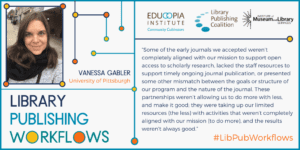Editor’s note: This is a guest post in our Library Publishing Workflow Evolution series, featuring reflections from our Library Publishing Workflows partners on how journal publishing workflows at their libraries have evolved over time. You can see the full documentation on the Library Publishing Workflows page.
By Vanessa Gabler, writing about her experiences at The University Library System at the University of Pittsburgh
Do more with less, and make it good. That’s how I think of our publishing program, and it informs many of our decisions about workflows at the University Library System, University of Pittsburgh (ULS). This is evident in our publishing workflows, as you can see in our Library Publishing Workflows documentation. We provide our journals with training, tools, resources, support, and a final metadata quality control check at the time of publication, but they are doing the editorial and production work themselves. With this approach, we can publish a significant number of journals with limited library resources. That same ethos has guided the development of a workflow for evaluating and accepting new journal partners.
Expanding the publishing program
 In the early days of our publishing program (2008–2011), we were flipping Pitt faculty print subscription journals to online with delayed open access, starting new open access journals with Pitt Faculty, and then taking on new and existing open access journals from non-Pitt partners around the world. We were so excited! And we still are, but we learned some lessons along the way. Some of the early journals we accepted weren’t completely aligned with our mission to support open access to scholarly research, lacked the staff resources to support timely ongoing journal publication, or presented some other mismatch between the goals or structure of our program and the nature of the journal. These partnerships weren’t allowing us to do more with less, and make it good; they were taking up our limited resources (the less) with activities that weren’t completely aligned with our mission (to do more), and the results weren’t always good.
In the early days of our publishing program (2008–2011), we were flipping Pitt faculty print subscription journals to online with delayed open access, starting new open access journals with Pitt Faculty, and then taking on new and existing open access journals from non-Pitt partners around the world. We were so excited! And we still are, but we learned some lessons along the way. Some of the early journals we accepted weren’t completely aligned with our mission to support open access to scholarly research, lacked the staff resources to support timely ongoing journal publication, or presented some other mismatch between the goals or structure of our program and the nature of the journal. These partnerships weren’t allowing us to do more with less, and make it good; they were taking up our limited resources (the less) with activities that weren’t completely aligned with our mission (to do more), and the results weren’t always good.
Focusing on mission alignment
So, we created selection criteria for our program and began asking prospective journals to complete a journal proposal form (2011). The selection criteria are a first pass to determine whether a journal fits with our mission. The journal proposal form is a deeper dive into the journal’s scope, people, policies, resources, and other pieces of information that help us to determine whether a partnership will be a good match. A journal proposal is the beginning of a collaborative process, and journals often learn for the first time what kinds of things they need to have in place to make a journal successful.
We also formed a Publications Advisory Board to review these proposals and make recommendations about whether to accept a journal (2012; it also provides input on our program policies and general direction). That process has also been collaborative, with Board members offering valuable advice to journals entering our program. We began soliciting external peer reviews by subject experts of journal proposals to assist the Board with making their recommendations (2019).
So how do selection criteria, a journal proposal form, a Publications Advisory Board, and external peer reviewers help us do more with less, and make it good? We standardized our service offerings and some journal policies to those that support our mission across journals, which promotes efficiencies for our staff (the day-to-day more). We partner with journals that are aligned with our mission to have an impact on the Open Access movement (the big more). We educate prospective journals about the resources, skills, and staffing needed to successfully run a journal in the long term, particularly in our program (how we do what we do with less). And we trust that our evaluation process, the program’s structure, and the ongoing relationships we cultivate with our journals will…make it good.
